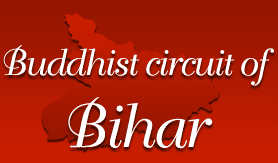|

District - Patna
Commissionery - Patna
Headquarter - Patna
Sub-Division - Patna Sadar, Danapur, Barh,
Masurhi, Patna City
Population - 36,18,211 (37 Lacs)
Area - 3,130,10 Sq. Km
Sea Level - 113 Meter
Language - Hindi, Maithily, Maghi, Bhojpuri
& Regional Language
Temperature -
Summer: 420C - 200C
Winter: 200C – 400C
Best Season - November – March
Road Route -
658 Km from Kolkata on N.H. 30
1088 Km. from Delhi
1802 Km. from Mumbai
Rail Route - Main Railway Station –
Patna
Air Route - Main Airport – Patna.
Directly connected from Delhi, Kolkata, Mumbai, Ahmedabad
& Ranchi
Main Spots of tourist Interest
Historical Importance
This region was the political centre of
North India from 6th BC to 5th AD. Centemporary of Lord Buddha,
famous Magadh King Ajatshatru put foundation of this new capital
in Patligram, coming from Rajgir, at the bank of river Ganga
& Sone. And his grandson Udayan developed the old Patliputra
City. In 461-445 BC it was the great capital of Magadh Kingdom.
Ancient Patliputra was the silent spectator of the rise &
fall of Maurya & Gupta dynasty. Great Chinese Traveller
Fahian (405-411 AD) & Heun-Stang (637 AD) visited this
place during their travel.
In Muslim era great king Shershah Suri made this capital in
16th Century. In 18th century; this region was Known as Ajimabad.
In the year 1912 it became the spearate state. Now this place
is the important trade centre of Eastern India. Today Patna
in known as the gateway of Buddhist & Jain circuit (Vaishali,
Rajgir, Nalanda, Bodh-gaya, Pawapuri) in India.
Places of Tourist Interests
Buddha Smriti
Park
Buddha Smriti Park, set up to commemorate the 2550th year
of Lord Buddha's Mahaparinirvana, in the heart of capital town near Patna Railway Junction. The theme of the
park is based on the histrorical relationship between Buddhism
and the state of Bihar. Spread over 20 acres, the park comprises
a large landscaped garden within which are located a relic
Stupa, a Museum meditation centre, and a multistorey car park.
Its design has been conceived around the enshrining of holy
relics of Lord Buddha. The park also has two saplings of the
sacred Bodhi tree brought from Bodh Gaya (India) and Anuradhapur
(Sri Lanka).
capital town near Patna Railway Junction. The theme of the
park is based on the histrorical relationship between Buddhism
and the state of Bihar. Spread over 20 acres, the park comprises
a large landscaped garden within which are located a relic
Stupa, a Museum meditation centre, and a multistorey car park.
Its design has been conceived around the enshrining of holy
relics of Lord Buddha. The park also has two saplings of the
sacred Bodhi tree brought from Bodh Gaya (India) and Anuradhapur
(Sri Lanka).
Stupa: The Stupa enshrining
the holy relics of the Lord Buddha, is the focal point of
the Buddha Smriti Park. Ambulatory paths around the stupa
for parikrama have been provided at different levels that
lead to the highest level of the building. The relics are
enshrined within the secure glass structure of the stupa and
is accessible for viewing.
Bodhi Trees: The park has saplings
of holy Bodhi trees which have been received from Mahameghavana
Anuradhapura, (Sri Lanka) and Bodh-Gaya, India.
Museum: The Museum building
impersonates the free flowing natural form of the Buddhist
cave monasteries of India 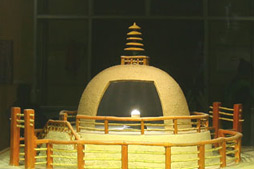 that
evolved from the earliest examples of Barabar caves found
in Bihar. The Museum will showcase the life and times of Lord
Buddha through original artifacts, 3-D models, audio-visual
medium and multi media presentations. that
evolved from the earliest examples of Barabar caves found
in Bihar. The Museum will showcase the life and times of Lord
Buddha through original artifacts, 3-D models, audio-visual
medium and multi media presentations.
There is a modern museum building within the Park. The museum
will showcase the life of Lord Buddha and the very essence
of Buddhism through original artifacts, three-dimensional
models, photographs, multi-media presentations, etc. Besides,
it would screen animation/dramatized films to acquaint the
visitors with the heritage of Buddhism and glorious culture
and history of Bihar.
Meditation Centre: The meditation
centre has been developed to create a unique facility dedicated
to the practice of meditation. The design is derived from
plan of the monasteries in the ancient Mahavihara of Nalanda.
It consists of a total of 60 air conditioned cells, each having
a view of the stupa enshrining the sacred relics of Lord Buddha.A
library consisting of books on Buddhism along with a large
Audio-visual hall for groups is also provided in this facility.
The air-conditioned meditation centre consists of three blocks,
and has modern facilities for the tourists and monks, with
a library and an audio-visual centre.
Park of Memories: The park
of memories is a landscaped open space which would have votive
stupas from countries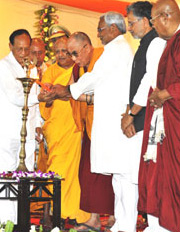 across the world, each designed in the architectural pattern
model example of the specific country. The park symbolically
represents the dispersion of Buddhism from Bihar to various
regions of the world.
across the world, each designed in the architectural pattern
model example of the specific country. The park symbolically
represents the dispersion of Buddhism from Bihar to various
regions of the world.
On the occasion of the 2250th year of Mahaparinirvana of
Lord Buddha, the idea of developing Buddha Smriti Park was
conceived by Shri Nitish Kumar, Chief Minister of Bihar to
showcase the glorious heritage of Buddha and the histrocial
role of Bihar in spreading Buddhism worldwide.
Inaugurated by His Holiness the Dalai Lama on the auspicious
day of Buddha Purnima, the holy day on which Lord Buddha was
born, got Enlightenment and Mahaparinirvana, the 27th May,
2010, the Buddha Smriti Park aspires to be an iconic landmark
for the people who value heritage and peace, all over the
world.
The Buddha Smriti park consists of an attractive garden with
water-bodies and fountains, a variety of trees and plants,
a meditation centre, a museum, a multi level parking and a
stupa housing the relic caskets of Lord Buddha, brought from
different countries such as Thailand, Myanmar, Sri Lanka and
Japan and presented by His Holiness the Dalai Lama.
Patna Museum
Location: In the heart of the
Capital town on Kotwali Thana Road, Near Dakbunglow Chauraha.
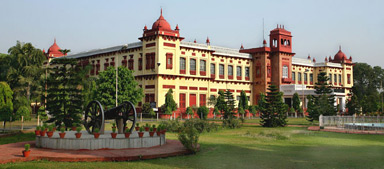 Importance:
Established in the year 1917, the Patna Museum is one of a
few best museums in India. With its presentation, Patna museum
is committed to impart a scientific vision to understand the
evolution of history, culture and art tradition of the land.
The Museum has thousands of exhibits of varied nature in its
possession, which includes Pre & Proto-historic objects,
stone sculptures, bronzes, terracottas, paintings - miniature
& thanka paintings, coins, miscellaneous art-objects and
so on. Importance:
Established in the year 1917, the Patna Museum is one of a
few best museums in India. With its presentation, Patna museum
is committed to impart a scientific vision to understand the
evolution of history, culture and art tradition of the land.
The Museum has thousands of exhibits of varied nature in its
possession, which includes Pre & Proto-historic objects,
stone sculptures, bronzes, terracottas, paintings - miniature
& thanka paintings, coins, miscellaneous art-objects and
so on.
This Museum has pride privilege of preserving the holy-relic
casket of Lord Buddha containing his ashes and other associated
materials discovered during excavation of a stupa belonging
to 6th Century B.C. at Vaishali.
Built in Indo-Sarcenic style, the Patna Museum building was
constructed in the year 1928 within its own measuring 700
x 500 sq.ft. The Patna Museum is a multipurpose museum. The
collections of varied nature can be classified into several
sections. Presently, there are altogether eleven classified
sections.
Buddha: The museum has a good
number of sculptures of the Gandhara and the Mathura art which
is chronologically synchronized with the age of Kushans. The Gandhar specimens
also known as 'Graeco-Buddhist Art' are made of blue schist
of Swat valley and the collection includes figures of Buddha,
Bodhisttavas and narrative panels as well. The panel depicting
the birth scene of Siddartha is undoubtedly important one
among the narrative panels. There are also a few specimens
of stucco figures. The sculptures of Mathura School depict
Buddha. Bodhisattavas, Hariti, Jataka, scenes and so on.
synchronized with the age of Kushans. The Gandhar specimens
also known as 'Graeco-Buddhist Art' are made of blue schist
of Swat valley and the collection includes figures of Buddha,
Bodhisttavas and narrative panels as well. The panel depicting
the birth scene of Siddartha is undoubtedly important one
among the narrative panels. There are also a few specimens
of stucco figures. The sculptures of Mathura School depict
Buddha. Bodhisattavas, Hariti, Jataka, scenes and so on.
Amongst Kushana sculptures from Bihar, special reference may
be made of the famous trio from Devangarh in the Nawada district.
Having obvious regional variation, the trio-consists of the
figures of Ekanamsa, Balarama and Vasudeva. Unlike conventional
one, images of Patna Museum trio are separately sculptured.
The Museum preserves a good number of sculptures of the Pala-Sena
school of art dated in between 8th & 12th century A.D.
These sculptures in this group are varied in 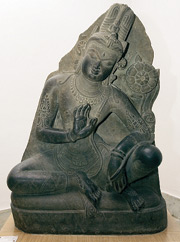 nature
and comprise Brahmanical, Buddhist, Jaina and several miscellaneous
sculptures. Particular mention may be made of a group of three
images of Avalokiteshvara, Maitreya and Buddha in bhumisparsh
posture discovered from Vishnupur (Gaya). One fine example
of the Pala craftsmanship may be seen in a spout ending gargogyle
(makara mukha-pranal). Patna Museum preserves a good number
of bronzes from Nalanda. These depict the deities of all major
religions; i.e. Buddhism, Jainism and Brahmanism prevalent
at that period. The figures are dated from post Gupta to Pala
period. nature
and comprise Brahmanical, Buddhist, Jaina and several miscellaneous
sculptures. Particular mention may be made of a group of three
images of Avalokiteshvara, Maitreya and Buddha in bhumisparsh
posture discovered from Vishnupur (Gaya). One fine example
of the Pala craftsmanship may be seen in a spout ending gargogyle
(makara mukha-pranal). Patna Museum preserves a good number
of bronzes from Nalanda. These depict the deities of all major
religions; i.e. Buddhism, Jainism and Brahmanism prevalent
at that period. The figures are dated from post Gupta to Pala
period.
The bronzes from Kurkihar numbering 163 are regarded as the
best collection of bronzes from any part of India. The Kurkihar
collection includes some of the marvellous bronzes in India,
such as figures of Buddha, Bodhisattavas, Tara, Balarama and
so on. These art pieces represent the high quality of the
metal art that flourished during the Pala period. A few of
these images are plated with gold.
Yakshini: Amongst the stone
sculptures a special mention must be made about the famous
female 'chauri bearer' figure of the Mauryan period, i.e.
3rd Cent. B.C. Discovered at Didarganj (Patna), the magnificent
statue is popularly known as Didarganj Yakshi. It is made
of pink Chunar sand stone and bears the typical Mauryan polish.
With a 'Chauri' in her right hand and slight forward inclined
posture, the charming figure demonstrates a modest appearance
and also reflects her humble submission towards the spectators.
Fossil Tree: Apart from the
historical and archaeological objects, Patna Museum has some
other interesting exhibits : such as a 53 feet long fossilized
tree of Pine family discovered near Asansol in 1927.
Harappa Findings: The Museum
has the honour to preserve a few of the important finds from
the classical Harappan sites which include terracotta figurines,
potteries, copper and bronze objects, seals-sealings and weights.
Jain: The highly lustured stone
torso of a Jain Tirthankar from Lohanipur (Patna) is the earliest
example of Jaina art. The lion head from Masarh (Bhojpur)
and the bull capital from Hajipur of Mauryan period are also
worth to mention.
The eighteen Jain bronzes from Chausa are one of the most
important collection of this Museum. These consist of Dharmachakra,
Kalpavriksha and sixteen images of Jain Tirthankaras. These
are the earliest known Jain bronzes in India and first known
bronze hoard from Gangetic valley. For the study of Jaina
iconography, besides bronzes from Chausa, metal images from
Aluara belonging to 11th-12th cent. A.D. are very important.
Out ot twenty nine, one depicts the Jain Ambika and rest the
Jaina Tirthankaras.
Hindu: A bi-facial Shalbhanjika,
carved on stone slab on high relief, is a finer specimen of
craftsmanship of late Mauryan-early Sunga period. The figure
is in her full youthful posture, twisting the branch of tree
with one of her hands. A female figures in stone from Sakarigalighat,
Rajmahal is a fine example of classical Gupta art skill. Tilted
as 'shuka kridarat nari' the figure is shown feeding a bird.
The sculpture depicts a sensuous and delicate beauty of womanhood.
It virtually portrays a happy janapada life of the period.
Among other stone images of the Gupta and the late Gupta period
the figures of Kartikeya, Agani, Ganesha from Mundeshwari
(Kaimur) are worth mentioning.
The bi-facial dancing figure of Kartikeya, belonging to post-Gupta
period from Mahrawan (Nawada), is unique as it is one of a
few sculptures discovered so far from North-India which represent
the dancing figures on the both sides of a wheel.
Some beautiful door frames with the figures of Ganga and Yamuna
are worth watching. There are also several other interesting
sculptures discovered from different regions. The museum possesses
the best collection of bronze, better known as astadhatu,
images in India. These bronzes were discovered from Chausa
(Buxar), Kurkihar (Gaya), Nalanda, Belwa (Saran), Aluara (Dhanbad),
Sonepur (Orissa) and Nagapattam (Tamilnadu). The Museum also
acquires a good number of bronzes discovered from Sonepur
(Orissa), Nagapattam (Tamilnadu) and Nellore (Andha Pradesh).
Pre-historic Objects: The pre-historic
objects include palaeoliths, microliths and neoliths from
different parts of Bihar and from foreign countries as well.
The palaeolithic tools from Bariar (M.P.) and Lalitpur (U.P.)
and also chellean and acheullean implements from Attrimpakkam
(Tamilnadu) are important. Besides, there are some fine neoliths
from Bihar and Uttar Pradesh kept in the museum.
Copper Hoards: The Patna Museum
possesses the biggest collection of copper hoards discovered
from different parts of Jharkhand & Bihar, viz.: Palamu,
Ranchi, Singhbhum, Hazaribagh, Munger, Dhanbad and Santhal-Pargana.
They represent the casting technique and the high skill in
the metallurgy of the period. The anthopomorphic copper object
found from Dhanbad district is unique and very important.
Terracotta Collection: The
terracotta collection of the Museum of superb and famous world
wide. Majority of these terracottas are from different parts
of Bihar, such as Patna, Vaishali, Belwa, Bodh-Gaya, Nalanda,
Chausa and so on. A good number of terracottas are brought
from Mathura, Varanasi and Pahadpur (Bangladesh) as well.
The terracotta figurines from Patna, mostly of the Maurya
age, are of great importance. The three dancing damsels, the
laughing boy and the smiling girl from the ancient city of
Pataliputra are very rare and technically superb. Besides,
there are numerous terracotta specimens which represent the
artistic excellence of the period. Female terracotta heads
from Buxar, belonging the Mauryan period, are highly elaborate
in their head dress and coiffure. Terracottas from Vaishali,
Bodh-Gaya, Mathura are examples of local craftsmanship. The
museum has some good collection of Gupta terracottas from
Kausambi. A beautiful plaque depicting Ramayan scene from
Chausa is an example of excellent classical Gupta art. The
large size plaques from Paharpur (Bangladesh) depict the technical
skill of the Pala period. There is a good collection of terracotta
seals and sealings from Vaishali, Nalanda and Dharawat.
Miniature Paintings: The Patna
Museum in its art repository has miniature paintings, thankas
and numerous decorative and miscellaneous art objects. The
collection consists of painting on paper of different schools;
such as - the Rajasthani, Mughal, Pahari, Delhi School and
Patan Qualam. These paintings range in date from beginnings
of the 16th to the end of the 19th century A.D. The classical
miniature paintings are varies in theme and they cover a broad
spectrum of content. Mention may be made of the paintings
related to the divine love of Radha and Krishna, scenes of
Ramayan, astanayika bheda, barahamasa, rag-ragini themes.
Three illustrated manuscripts of Jain Uttaradhayayan Sutra
on paper are also very important. The paintings of Delhi School
are both on paper and ivory.
The Patna Museum has in its possession a fairly good number
of Patna School or Patna Qalam paintings which flourished
in the city of Patna itself for about two centuries right
from 1760 A.D. to early decades of 20th century. These paintings
are painted on paper, mica and ivory.
The Museum has pride privilege of having the collecton of
tibetan scroll paintings on silk which were presented by Rahul
Sankrityayan. These Thankas are dated from 17th to 19th century
A.D. The Tibetan scroll paintings mainly depict Buddha, Bodhisattava,
Dalai Lamas, different Tantrayani deities, Chakrasamvar and
so on.
The Patna Museum has got a very good collection of coins which
are quite representative of different periods and dynasties
ranging from earliest punch marked coins to modern commemorative
coins.
There are a good number of gold coins of the Kushanas, Guptas
and Mughal rulers in the coin cabinet of Patna Museum.
MEMORIES OF DR. RAJENDRA PRASAD:
The musem also displays the gifts of late Dr. Rajendra Prasad,
the first President of Indian Reupublic, which he had received
durng the tenure of his Presidency.
Besides the above and so many underscribed ones, there are
a few very rare collection housed in the museum. Two small
gold repousse of caparisoned couchant humped bulls from Vaishlai
are important for the study of metal art. A male standing
figure with a turban on the head and holding a chamar, discoverd
from Vaishali excavations, is an example of fine craftsmanship.
A gold repouses from sultanganj displays a female figure within
an oval plaque. This piece of art can be dated of Gupta period.
In the category of rare collection mention may also be made
of a group of 23 stone discs from Murtaziganj (Patna). The
intricacy of ivory engraving and exquisite finish of jewellery
making technique reprsent the high aesthetic taste of the
people of the Maurya-Sunga period.
The old-arms, like swords, daggers, shield, bangnakha, guns
belonging to medieval period and cannon of First & Second
World Wars create special interest in every visitor. Some
stuffed wild life specimens, in which some are extinct, attract
children and elders alike.

|
